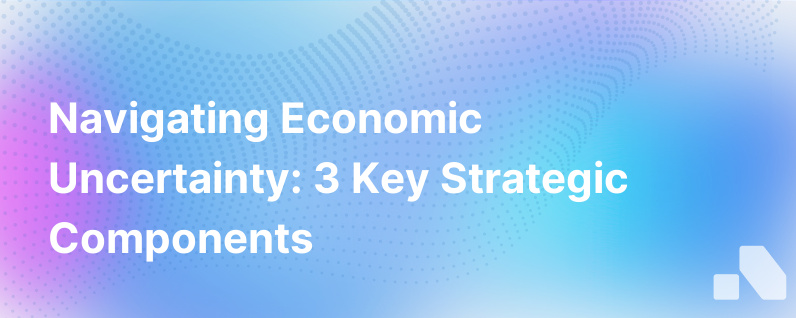The 3 Strategic Components Of Navigating Economic Uncertainty
Published on January 7, 2024 by David Zhang
The modern business landscape is frequently characterised by rapid change and unpredictability. Economic uncertainty can arise from various sources, including geopolitical tensions, natural disasters, technological disruption, or a global health crisis, such as the recent COVID-19 pandemic. In such a context, companies need a robust strategy to manage the ambiguity and maintain a decisive edge in the marketplace.
To survive and thrive in these challenging conditions, businesses must focus on three strategic components: financial resilience, adaptability, and market insight. Here we will explore each of these components in detail, offering insights into their significance and practical ways to enhance them in your organization.
Financial Resilience: The Foundation of Security
Financial resilience is the bedrock on which companies can withstand economic shocks. It's the ability to endure short-term financial hardship without compromising long-term viability. This resilience comes from several financial disciplines:
-
Conservative Capital Management: Companies need a strong cash reserve to navigate periods of reduced cash flow. This requires prudent management of profits, careful investment strategies, and a conservative approach to debt.
-
Strategic Cost Control: Frequent evaluation of operational costs ensures that businesses aren't squandering resources. During uncertainty, the focus should shift to essential expenditures and cost-savings, without stifling innovation.
-
Diversified Revenue Streams: A diversification strategy can mitigate risks associated with economic downturns. By spreading revenue sources across different products, services, or markets, businesses can protect against sector-specific declines.
-
Smart Funding Cultivation: Even in challenging economic climates, opportunities for funding exist. Businesses should foster relations with potential investors or lenders long before the need arises, as credit markets can tighten during downturns.
Practical steps to build financial resilience include conducting regular financial health checks, creating predictive cash flow models, and developing contingency plans that can be activated when warning signals are identified.
Adaptability: Agile Responses to an Evolving Market
Adaptability refers to the capacity to pivot or adjust strategies swiftly in response to changing circumstances. Agile companies possess a clear competitive advantage because they can exploit opportunities that arise out of the chaos of uncertainty.
Key facets of adaptability include:
-
Innovation Culture: Encourage a culture of continuous innovation where new ideas are welcomed and trialled. Whether it’s new products, services, or internal processes, innovation keeps the business evolving and better equipped to handle changes.
-
Flexible Operations: Flexible work arrangements, scalable business models, and adaptable supply chains allow companies to alter operations quickly and efficiently.
-
Strategic Risk Management: While all risks can't be eliminated, they can be managed. Scenario planning, risk assessments, and regular strategy reviews prepare businesses to respond to potential threats proactively.
-
Continuous Learning: Ensure that your team is constantly upskilling and cross-skilling. In times of uncertainty, the ability to redeploy competent staff to different areas of the business can be invaluable.
In practice, adaptability might involve embracing digital transformation, implementing advanced analytics to understand shifting patterns, or revising product portfolios in line with changing customer preferences.
Market Insight: The Compass Through the fog
The value of deep market insight becomes especially apparent during times of uncertainty. Understanding how macroeconomic factors affect the business, along with possessing keen insight into customer behaviour, can provide the foresight needed to steer the company in the right direction.
Breakdown of market insight:
-
Customer-Centricity: Stay close to your customers; understand their evolving needs and worries. A client-centered approach allows you to adjust your value proposition to address new pain points.
-
Competitive Analysis: Monitor competitors closely. They may react to uncertainty with innovations or strategic shifts that could provide learning opportunities or threat warnings.
-
Macro-environment Awareness: Keep abreast of global economic indicators, industry trends, and regulatory changes. This strategic vigilance helps anticipate broader shifts that could impact the business.
-
Leveraging Data Analytics: Employ data analytics to decipher market trends and predict future shifts. Data-driven decisions tend to be more reliable than those based on intuition, especially in volatile times.
To enhance market insight, invest in customer relationship management (CRM) systems, develop a strong social media presence for real-time customer feedback, and utilise economic forecasting tools.
Conclusion
When economic uncertainty looms, applying a strategic approach centered on financial resilience, adaptability, and market insight, can make the difference between those businesses that merely survive and those that find new avenues for growth. The synergy of these components enables an organization not just to navigate the storm of economic uncertainty but also to emerge from it more robust and more competitive than before.
For businesses seeking to consolidate these strategic components, advanced platforms like Aomni help streamline the process. Leveraging real-time market intelligence and competitive insights, tools like Aomni can be vital for crafting personalized, strategic content that keeps sales agile in the rapidly-evolving B2B landscape.
Weathering economic turbulence requires fortitude and foresight. By turning attention to building financial resilience, fostering adaptability, and deepening market insight, businesses can not only face uncertainty with confidence but embrace it as a catalyst for innovation and growth.